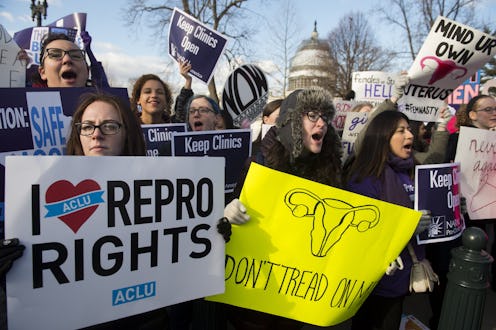Life
How Common Are Abortion Waiting Periods?
Abortion access might be a right, but as we all know by now, it's not a right that's always easy to exercise. In fact, now that Florida has passed a new abortion waiting period law, six in 10 women are now subject to abortion waiting periods in the United States. Such is the conclusion The Daily Beast came to when the cross referenced U.S. Census data with information from the Guttmacher Institute. Clearly the assault on reproductive rights we've seen in the past few years has been having a widespread impact.
In Florida, the third most populous state in the country, waiting period requirements were signed into law last summer. The American Civil Liberties Union and the Center for Reproductive Rights quickly sued and filed for an injunction, which was granted; however, when the injunction was lifted by an appeals court in February, Florida became the 28th state to have a waiting period for abortion. The number of women who are subject to a waiting period before they are allowed to have an abortion accordingly ashifted from 53 percent to 59 percent.
Waiting period laws, which require women wait a minimum amount of time between initially seeking an abortion and actually obtaining one, are becoming more and more common around the country. Most states with waiting periods, Florida included, require a woman to wait 24 hours; however, waiting periods may also range from 18 hours in Idaho to 72 hours in Missouri, North Carolina, Oklahoma, South Dakota and Utah. Having to wait between seeking an abortion and obtaining one effectively forces women to make two trips to a clinic, which can be incredibly difficult: In a number of states, women are required to travel long distances to reach a clinic that offers abortion coverage, making access to the procedure impossible for many.
And if Texas law HB2 is upheld by the Supreme Court, you can expect clinics to become even more scarce.
All in all, around a third of all states in the United States already have a failing grade when it comes to reproductive rights, and the number of lawmakers who seem intent on trying to limit access to abortion seems to only be growing. Waiting periods are a particularly popular tactic, especially since they can seem so reasonable, and are often pitched as being good for women. In Florida, for instance, the legislator who introduced the waiting period bill called the decision to lift the injunction, "a huge win for women's health and the ability for women to have a face to face consultation with the doctor before the procedure."
However, for women who have to drive more than an hour — or worse, more than three or four hours in both directions — to reach a clinic that offers abortion, low income women who can't afford to miss more than a day of work, or women who are in an abusive relationship and would be unsafe if their partner discovered they were pregnant or planning to terminate a pregnancy, waiting periods can in fact make it impossible in a practical sense for a woman to obtain an abortion at all. This effectively cuts off access to something which — as a reminder — is not only safe, but also absolutely legal.
Also worth noting is the fact that many states that require a waiting period for an abortion don't place any such restriction on buying a gun, including Alabama, Arizona, Arkansas, Georgia, Idaho, Indiana, Kansas, Kentucky, Louisiana, Michigan, Mississippi, Missouri, North Dakota, Ohio, Oklahoma, Pennsylvania, South Carolina, South Dakota, Texas, Utah, Virginia, and West Virginia.
When someone's right to own a deadly weapon is considered more pressing than the right to bodily autonomy, we have a problem.
And then when you consider that abortion clinics are being forced to close across the country, that crisis pregnancy centers receive state and federal funding, that there are still people looking to defund Planned Parenthood, and that 59 percent of women live in a state where waiting periods are law...well, it's not just a problem. It's a lot of problems. And they're problems that badly, badly need solving.
Image: Giphy
